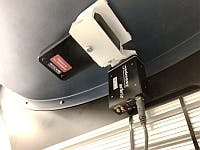DOE evaluates handheld meter effectiveness for characterizing SSL flicker
Dedicated meters and add-on subsystems for smartphones can provide lighting designers and specifiers with a convenient means of evaluating flicker in the field, but the effectiveness of the available test and measurement products varies significantly.
The US Department of Energy (DOE) has published research evaluating handheld flicker measurement devices and discerning how well such systems perform. The testing was performed by the agency’s Pacific Northwest National Laboratory (PNNL) in which dedicated handheld meters and add-on subsystems for smart phones were compared with a laboratory, scientific-grade meter. Not surprisingly, the results varied significantly, and of course the solid-state lighting (SSL) sector still lacks a perfect metric and methodology for characterizing flicker.
The technical term for flicker is temporal light modulation (TLM) or the variation in light output from a source over time. All light sources can have some amount of flicker. In LED-based SSL, the driver topology and quality of design generally determine the level of flicker and the comfort of people exposed to the light source.
The PNNL research does address the ongoing issue of less-than-perfect metrics for measuring flicker. The most common metrics are Percent Flicker (sometimes called Modulation Depth or Percent Modulation) and Flicker Index. We had a contributed feature article a year back that covered these two metrics and some of the basics of the phenomena.
The IEEE (Institute of Electrical and Electronics Engineers) also published a flicker characterization methodology, IEEE 1789, that would presumably identify safe light sources. We covered some of those details in another feature article. But most in the SSL sector view the IEEE work as overly strict, and it’s lacking in that it does not take into account the duty cycle of a source.
The US Department of Energy (DOE) has released a report comparing commercially-available handheld flicker meters alongside a reference meter. (Image credits: Table and article thumbnail courtesy of the US Department of Energy, available in the public domain, published in “Characterizing Photometric Flicker: Handheld Meters.”)
The Admesy Asteria SC-ASTR-01 High-Speed Illuminance Photometer was used as the lab reference for the PNNL tests and was connected to a 2m integrating sphere in the PNNL lab. The portable meters tested by the PNNL were all capable of measuring Percent Flicker and Flicker Index. And generally the products had capabilities of measuring other metrics. For example, the Stroboscopic Effect Visibility Measure (SVM) is gaining in popularity and relies on a Fourier analysis of the light output over time. But experts believe more work is needed on SVM. Several of the products could calculate SVM. The Lighting Research Center (LRC) at Rensselaer Polytechnic Institute also developed a metric called the Flicker Perception Metric (MP), and one of the meters tested could handle the LRC metric.
The portable products tested include:
- Viso Systems Flicker Tester app for the iPhone
- Viso Systems LabFlicker
- AsenseTek Lighting Passport Pro
- Fauser Light LM10
- UPRtek MK350N Premium
- Everfine SFIM-300
- Just Normlicht GL Optic Spectis 1.0 T
- Gigahertz-Optik BTS256-EF
- Admesy AsteriaSC-ASTR-01
Light sources tested with the meters ranged from legacy incandescent and fluorescent lamps to LED replacement lamps to LED-based integral luminaires. The results are far too detailed to discuss here, but you can peruse details for each of the test products in the DOE report.
Generally, the portable meters don’t match the capabilities of laboratory instruments. But even a smartphone app using the camera on the phone can provide basic measurements within 10% accuracy of a lab instrument. But the limitations of the handheld meters are really in the details. All of the meters have specific limitations such as sensitivity at lower light levels and the frequency of flicker present. The DOE said the meters could prove useful in determining that a problem exists in a lighting installation, but more precise equipment would be needed during product development and even end-product selection.
One positive consideration to note is just how far portable photometric test products have come. It wasn’t too long ago that it would not have been conceivable to have a meter in your pocket that could capture spectral power distribution (SPD). And the flicker capability of portable meters should get better rapidly alongside further development in the metrics area.

Maury Wright | Editor in Chief
Maury Wright is an electronics engineer turned technology journalist, who has focused specifically on the LED & Lighting industry for the past decade. Wright first wrote for LEDs Magazine as a contractor in 2010, and took over as Editor-in-Chief in 2012. He has broad experience in technology areas ranging from microprocessors to digital media to wireless networks that he gained over 30 years in the trade press. Wright has experience running global editorial operations, such as during his tenure as worldwide editorial director of EDN Magazine, and has been instrumental in launching publication websites going back to the earliest days of the Internet. Wright has won numerous industry awards, including multiple ASBPE national awards for B2B journalism excellence, and has received finalist recognition for LEDs Magazine in the FOLIO Eddie Awards. He received a BS in electrical engineering from Auburn University.






